An In-Depth Analysis of Nike's Supply Chain Management Processes
VerifiedAdded on 2022/08/21
|10
|2252
|29
Report
AI Summary
This report provides a comprehensive analysis of Nike's supply chain management, focusing on its inventory processes, Just-in-Time (JIT) delivery system, and lean management strategies. It examines Nike's current inventory management practices, highlighting its overarching principles and global manufacturing strategy. The report delves into the company's implementation of JIT and lean methodologies, including factory outsourcing, and assesses their impact on productivity, lead times, and waste reduction. The study also explores the benefits of Nike's branding, celebrity endorsements, and commitment to quality. By analyzing these elements, the report offers insights into how Nike has optimized its supply chain to achieve efficiency, reduce costs, and deliver value to its customers, ultimately contributing to its success as a global leader in the athletic apparel and footwear industry.

Running head: SUPPLY CHAIN 1
Supply Chain
Name of Student
Institution Affiliation
Supply Chain
Name of Student
Institution Affiliation
Paraphrase This Document
Need a fresh take? Get an instant paraphrase of this document with our AI Paraphraser
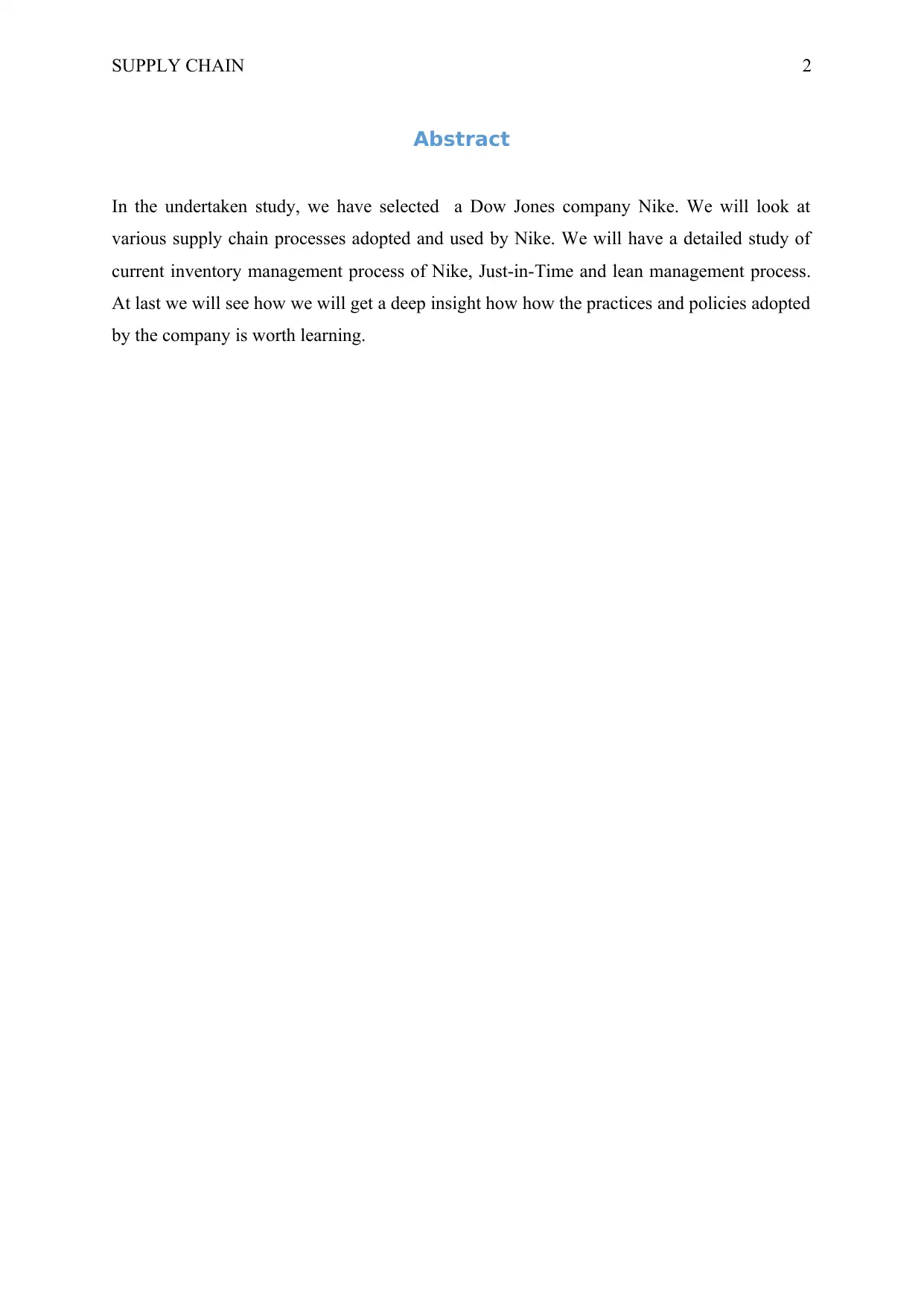
SUPPLY CHAIN 2
Abstract
In the undertaken study, we have selected a Dow Jones company Nike. We will look at
various supply chain processes adopted and used by Nike. We will have a detailed study of
current inventory management process of Nike, Just-in-Time and lean management process.
At last we will see how we will get a deep insight how how the practices and policies adopted
by the company is worth learning.
Abstract
In the undertaken study, we have selected a Dow Jones company Nike. We will look at
various supply chain processes adopted and used by Nike. We will have a detailed study of
current inventory management process of Nike, Just-in-Time and lean management process.
At last we will see how we will get a deep insight how how the practices and policies adopted
by the company is worth learning.
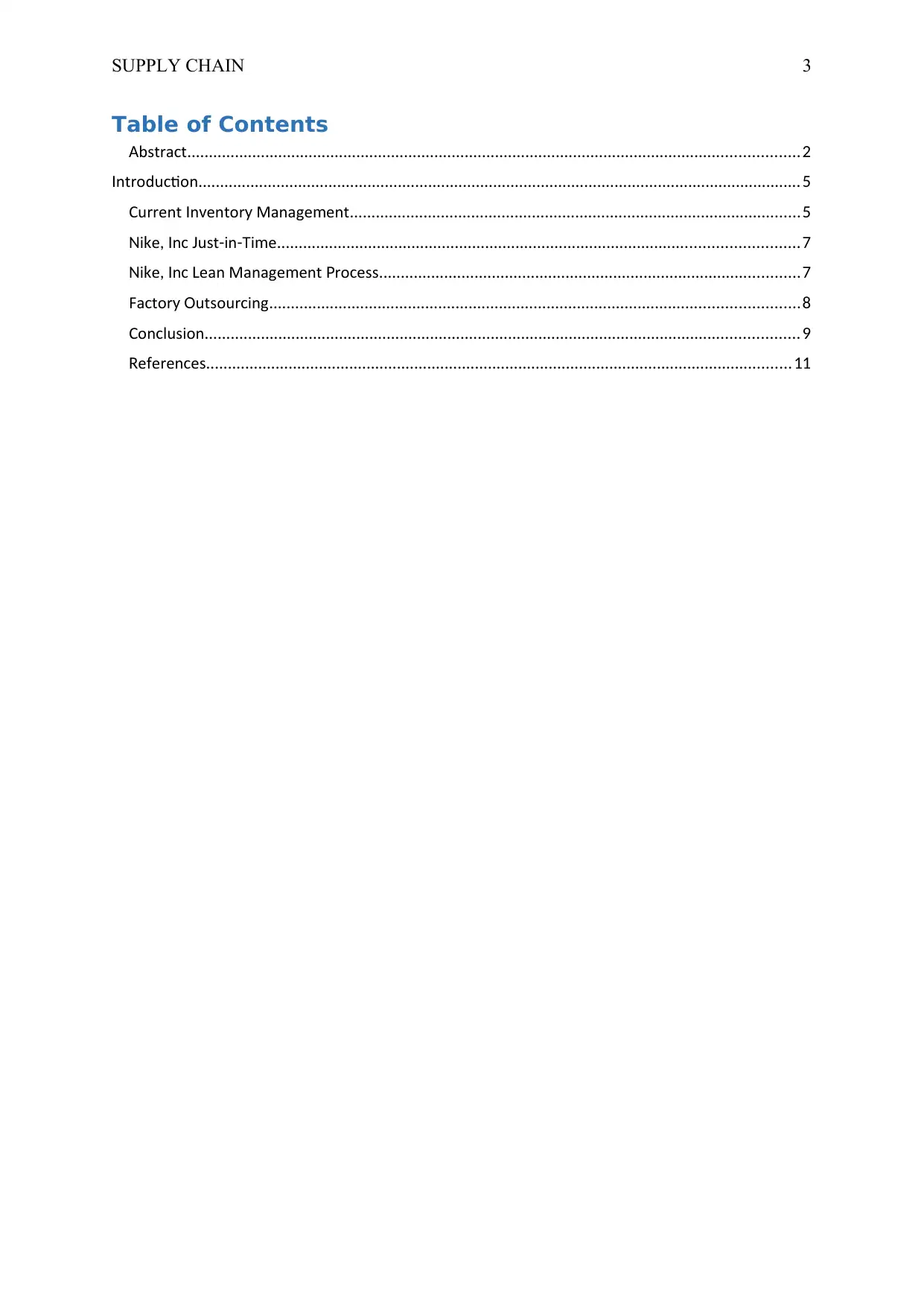
SUPPLY CHAIN 3
Table of Contents
bstra tA c .............................................................................................................................................2
ntrodu tionI c ...........................................................................................................................................5
Current n entor Manage entI v y m ........................................................................................................5
i e n ust in Ti eN k , I c J - - m ........................................................................................................................7
i e n ean Manage ent ro essN k , I c L m P c .................................................................................................7
Fa tor utsour ingc y O c ..........................................................................................................................8
Con lusionc .........................................................................................................................................9
eferen esR c .......................................................................................................................................11
Table of Contents
bstra tA c .............................................................................................................................................2
ntrodu tionI c ...........................................................................................................................................5
Current n entor Manage entI v y m ........................................................................................................5
i e n ust in Ti eN k , I c J - - m ........................................................................................................................7
i e n ean Manage ent ro essN k , I c L m P c .................................................................................................7
Fa tor utsour ingc y O c ..........................................................................................................................8
Con lusionc .........................................................................................................................................9
eferen esR c .......................................................................................................................................11
⊘ This is a preview!⊘
Do you want full access?
Subscribe today to unlock all pages.

Trusted by 1+ million students worldwide
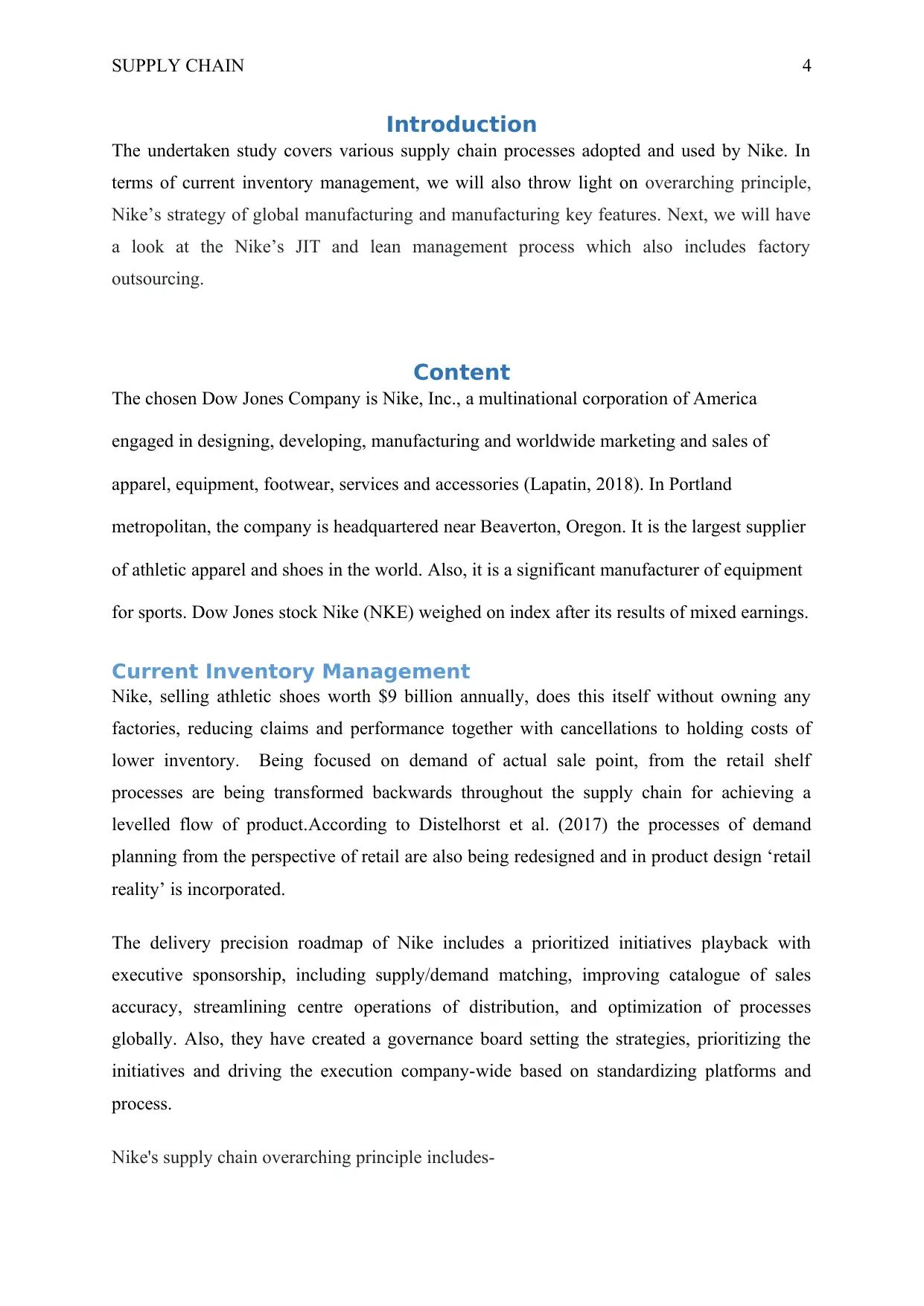
SUPPLY CHAIN 4
Introduction
The undertaken study covers various supply chain processes adopted and used by Nike. In
terms of current inventory management, we will also throw light on overarching principle,
Nike’s strategy of global manufacturing and manufacturing key features. Next, we will have
a look at the Nike’s JIT and lean management process which also includes factory
outsourcing.
Content
The chosen Dow Jones Company is Nike, Inc., a multinational corporation of America
engaged in designing, developing, manufacturing and worldwide marketing and sales of
apparel, equipment, footwear, services and accessories (Lapatin, 2018). In Portland
metropolitan, the company is headquartered near Beaverton, Oregon. It is the largest supplier
of athletic apparel and shoes in the world. Also, it is a significant manufacturer of equipment
for sports. Dow Jones stock Nike (NKE) weighed on index after its results of mixed earnings.
Current Inventory Management
Nike, selling athletic shoes worth $9 billion annually, does this itself without owning any
factories, reducing claims and performance together with cancellations to holding costs of
lower inventory. Being focused on demand of actual sale point, from the retail shelf
processes are being transformed backwards throughout the supply chain for achieving a
levelled flow of product.According to Distelhorst et al. (2017) the processes of demand
planning from the perspective of retail are also being redesigned and in product design ‘retail
reality’ is incorporated.
The delivery precision roadmap of Nike includes a prioritized initiatives playback with
executive sponsorship, including supply/demand matching, improving catalogue of sales
accuracy, streamlining centre operations of distribution, and optimization of processes
globally. Also, they have created a governance board setting the strategies, prioritizing the
initiatives and driving the execution company-wide based on standardizing platforms and
process.
Nike's supply chain overarching principle includes-
Introduction
The undertaken study covers various supply chain processes adopted and used by Nike. In
terms of current inventory management, we will also throw light on overarching principle,
Nike’s strategy of global manufacturing and manufacturing key features. Next, we will have
a look at the Nike’s JIT and lean management process which also includes factory
outsourcing.
Content
The chosen Dow Jones Company is Nike, Inc., a multinational corporation of America
engaged in designing, developing, manufacturing and worldwide marketing and sales of
apparel, equipment, footwear, services and accessories (Lapatin, 2018). In Portland
metropolitan, the company is headquartered near Beaverton, Oregon. It is the largest supplier
of athletic apparel and shoes in the world. Also, it is a significant manufacturer of equipment
for sports. Dow Jones stock Nike (NKE) weighed on index after its results of mixed earnings.
Current Inventory Management
Nike, selling athletic shoes worth $9 billion annually, does this itself without owning any
factories, reducing claims and performance together with cancellations to holding costs of
lower inventory. Being focused on demand of actual sale point, from the retail shelf
processes are being transformed backwards throughout the supply chain for achieving a
levelled flow of product.According to Distelhorst et al. (2017) the processes of demand
planning from the perspective of retail are also being redesigned and in product design ‘retail
reality’ is incorporated.
The delivery precision roadmap of Nike includes a prioritized initiatives playback with
executive sponsorship, including supply/demand matching, improving catalogue of sales
accuracy, streamlining centre operations of distribution, and optimization of processes
globally. Also, they have created a governance board setting the strategies, prioritizing the
initiatives and driving the execution company-wide based on standardizing platforms and
process.
Nike's supply chain overarching principle includes-
Paraphrase This Document
Need a fresh take? Get an instant paraphrase of this document with our AI Paraphraser
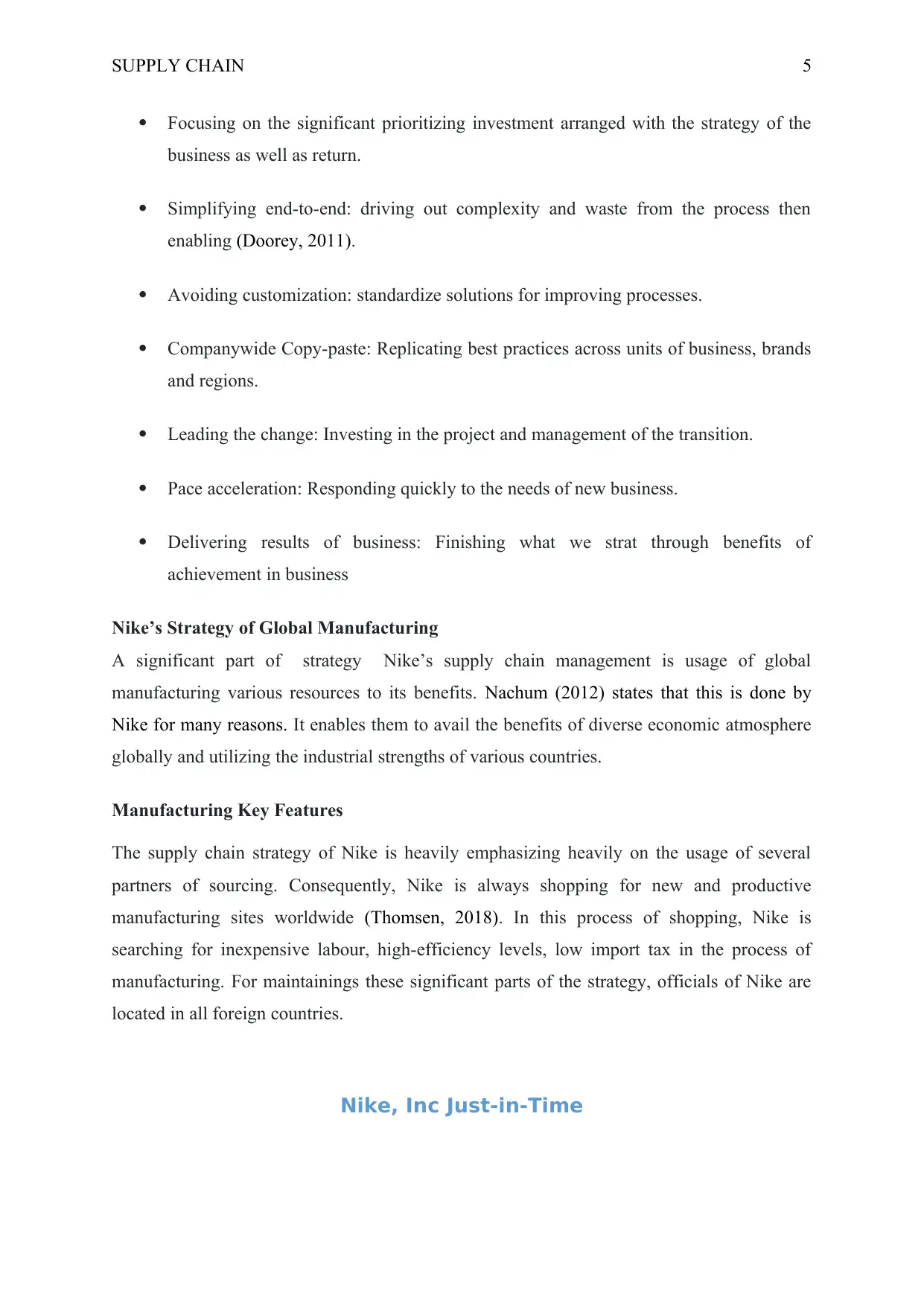
SUPPLY CHAIN 5
Focusing on the significant prioritizing investment arranged with the strategy of the
business as well as return.
Simplifying end-to-end: driving out complexity and waste from the process then
enabling (Doorey, 2011).
Avoiding customization: standardize solutions for improving processes.
Companywide Copy-paste: Replicating best practices across units of business, brands
and regions.
Leading the change: Investing in the project and management of the transition.
Pace acceleration: Responding quickly to the needs of new business.
Delivering results of business: Finishing what we strat through benefits of
achievement in business
Nike’s Strategy of Global Manufacturing
A significant part of strategy Nike’s supply chain management is usage of global
manufacturing various resources to its benefits. Nachum (2012) states that this is done by
Nike for many reasons. It enables them to avail the benefits of diverse economic atmosphere
globally and utilizing the industrial strengths of various countries.
Manufacturing Key Features
The supply chain strategy of Nike is heavily emphasizing heavily on the usage of several
partners of sourcing. Consequently, Nike is always shopping for new and productive
manufacturing sites worldwide (Thomsen, 2018). In this process of shopping, Nike is
searching for inexpensive labour, high-efficiency levels, low import tax in the process of
manufacturing. For maintainings these significant parts of the strategy, officials of Nike are
located in all foreign countries.
Nike, Inc Just-in-Time
Focusing on the significant prioritizing investment arranged with the strategy of the
business as well as return.
Simplifying end-to-end: driving out complexity and waste from the process then
enabling (Doorey, 2011).
Avoiding customization: standardize solutions for improving processes.
Companywide Copy-paste: Replicating best practices across units of business, brands
and regions.
Leading the change: Investing in the project and management of the transition.
Pace acceleration: Responding quickly to the needs of new business.
Delivering results of business: Finishing what we strat through benefits of
achievement in business
Nike’s Strategy of Global Manufacturing
A significant part of strategy Nike’s supply chain management is usage of global
manufacturing various resources to its benefits. Nachum (2012) states that this is done by
Nike for many reasons. It enables them to avail the benefits of diverse economic atmosphere
globally and utilizing the industrial strengths of various countries.
Manufacturing Key Features
The supply chain strategy of Nike is heavily emphasizing heavily on the usage of several
partners of sourcing. Consequently, Nike is always shopping for new and productive
manufacturing sites worldwide (Thomsen, 2018). In this process of shopping, Nike is
searching for inexpensive labour, high-efficiency levels, low import tax in the process of
manufacturing. For maintainings these significant parts of the strategy, officials of Nike are
located in all foreign countries.
Nike, Inc Just-in-Time
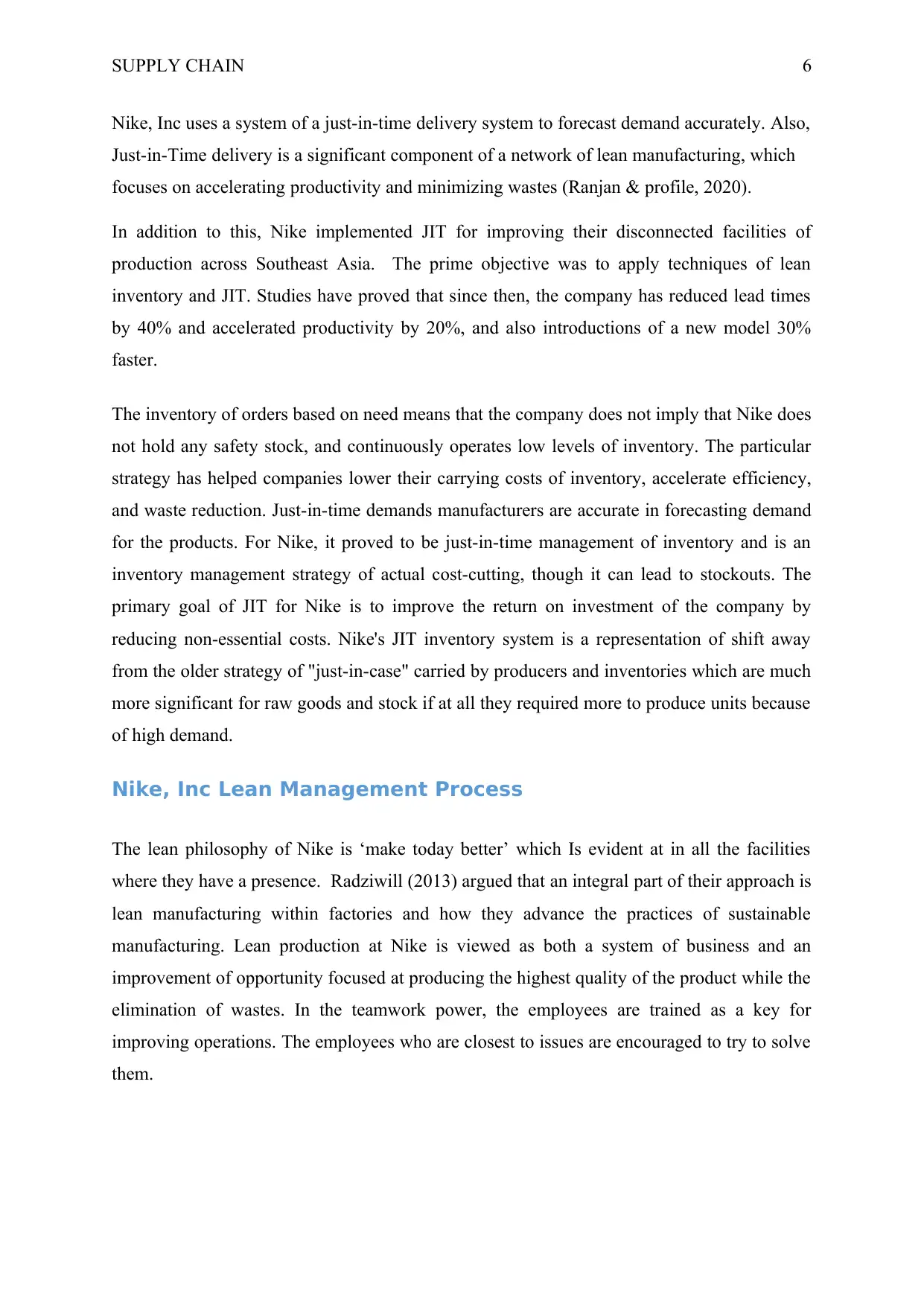
SUPPLY CHAIN 6
Nike, Inc uses a system of a just-in-time delivery system to forecast demand accurately. Also,
Just-in-Time delivery is a significant component of a network of lean manufacturing, which
focuses on accelerating productivity and minimizing wastes (Ranjan & profile, 2020).
In addition to this, Nike implemented JIT for improving their disconnected facilities of
production across Southeast Asia. The prime objective was to apply techniques of lean
inventory and JIT. Studies have proved that since then, the company has reduced lead times
by 40% and accelerated productivity by 20%, and also introductions of a new model 30%
faster.
The inventory of orders based on need means that the company does not imply that Nike does
not hold any safety stock, and continuously operates low levels of inventory. The particular
strategy has helped companies lower their carrying costs of inventory, accelerate efficiency,
and waste reduction. Just-in-time demands manufacturers are accurate in forecasting demand
for the products. For Nike, it proved to be just-in-time management of inventory and is an
inventory management strategy of actual cost-cutting, though it can lead to stockouts. The
primary goal of JIT for Nike is to improve the return on investment of the company by
reducing non-essential costs. Nike's JIT inventory system is a representation of shift away
from the older strategy of "just-in-case" carried by producers and inventories which are much
more significant for raw goods and stock if at all they required more to produce units because
of high demand.
Nike, Inc Lean Management Process
The lean philosophy of Nike is ‘make today better’ which Is evident at in all the facilities
where they have a presence. Radziwill (2013) argued that an integral part of their approach is
lean manufacturing within factories and how they advance the practices of sustainable
manufacturing. Lean production at Nike is viewed as both a system of business and an
improvement of opportunity focused at producing the highest quality of the product while the
elimination of wastes. In the teamwork power, the employees are trained as a key for
improving operations. The employees who are closest to issues are encouraged to try to solve
them.
Nike, Inc uses a system of a just-in-time delivery system to forecast demand accurately. Also,
Just-in-Time delivery is a significant component of a network of lean manufacturing, which
focuses on accelerating productivity and minimizing wastes (Ranjan & profile, 2020).
In addition to this, Nike implemented JIT for improving their disconnected facilities of
production across Southeast Asia. The prime objective was to apply techniques of lean
inventory and JIT. Studies have proved that since then, the company has reduced lead times
by 40% and accelerated productivity by 20%, and also introductions of a new model 30%
faster.
The inventory of orders based on need means that the company does not imply that Nike does
not hold any safety stock, and continuously operates low levels of inventory. The particular
strategy has helped companies lower their carrying costs of inventory, accelerate efficiency,
and waste reduction. Just-in-time demands manufacturers are accurate in forecasting demand
for the products. For Nike, it proved to be just-in-time management of inventory and is an
inventory management strategy of actual cost-cutting, though it can lead to stockouts. The
primary goal of JIT for Nike is to improve the return on investment of the company by
reducing non-essential costs. Nike's JIT inventory system is a representation of shift away
from the older strategy of "just-in-case" carried by producers and inventories which are much
more significant for raw goods and stock if at all they required more to produce units because
of high demand.
Nike, Inc Lean Management Process
The lean philosophy of Nike is ‘make today better’ which Is evident at in all the facilities
where they have a presence. Radziwill (2013) argued that an integral part of their approach is
lean manufacturing within factories and how they advance the practices of sustainable
manufacturing. Lean production at Nike is viewed as both a system of business and an
improvement of opportunity focused at producing the highest quality of the product while the
elimination of wastes. In the teamwork power, the employees are trained as a key for
improving operations. The employees who are closest to issues are encouraged to try to solve
them.
⊘ This is a preview!⊘
Do you want full access?
Subscribe today to unlock all pages.

Trusted by 1+ million students worldwide
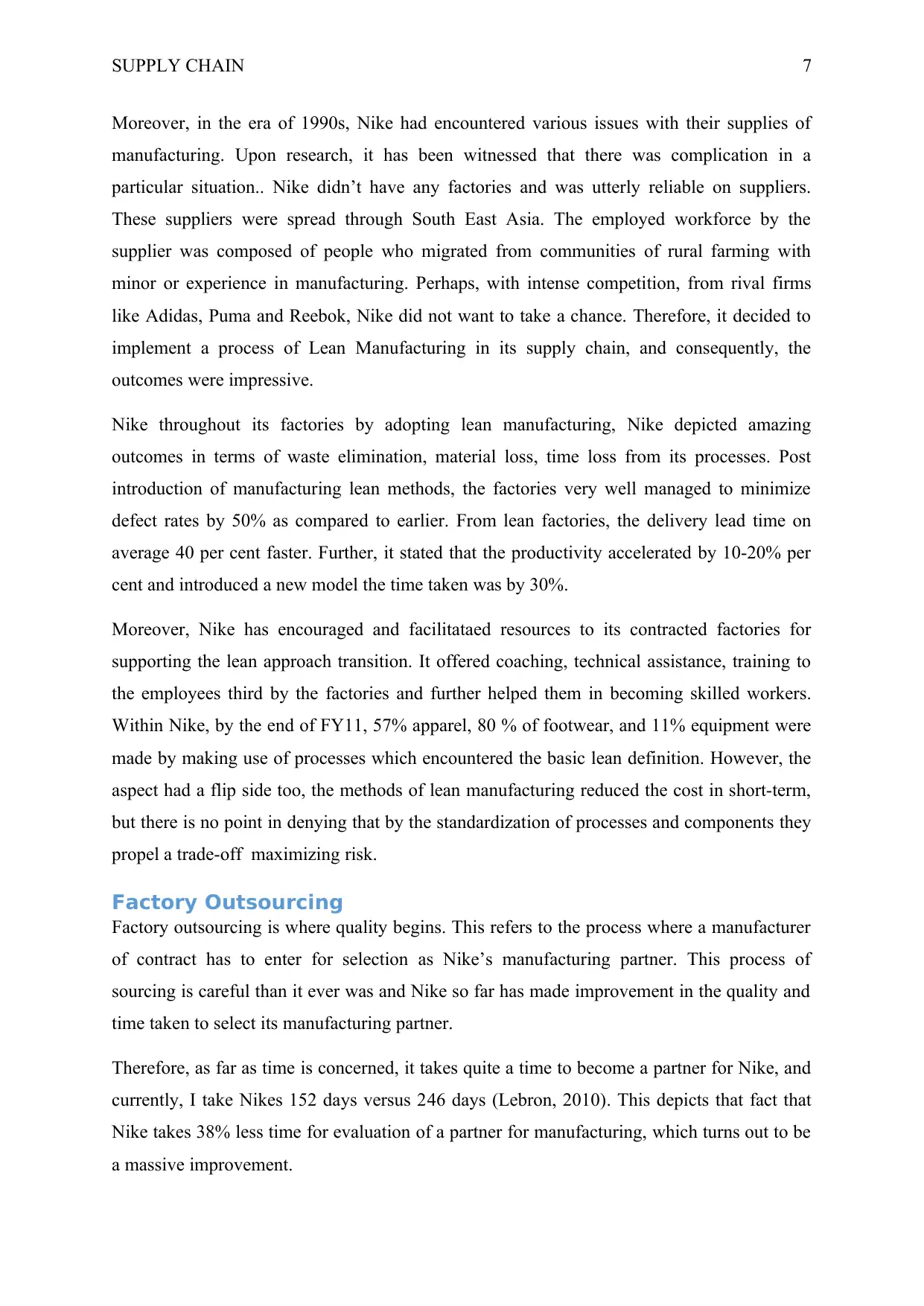
SUPPLY CHAIN 7
Moreover, in the era of 1990s, Nike had encountered various issues with their supplies of
manufacturing. Upon research, it has been witnessed that there was complication in a
particular situation.. Nike didn’t have any factories and was utterly reliable on suppliers.
These suppliers were spread through South East Asia. The employed workforce by the
supplier was composed of people who migrated from communities of rural farming with
minor or experience in manufacturing. Perhaps, with intense competition, from rival firms
like Adidas, Puma and Reebok, Nike did not want to take a chance. Therefore, it decided to
implement a process of Lean Manufacturing in its supply chain, and consequently, the
outcomes were impressive.
Nike throughout its factories by adopting lean manufacturing, Nike depicted amazing
outcomes in terms of waste elimination, material loss, time loss from its processes. Post
introduction of manufacturing lean methods, the factories very well managed to minimize
defect rates by 50% as compared to earlier. From lean factories, the delivery lead time on
average 40 per cent faster. Further, it stated that the productivity accelerated by 10-20% per
cent and introduced a new model the time taken was by 30%.
Moreover, Nike has encouraged and facilitataed resources to its contracted factories for
supporting the lean approach transition. It offered coaching, technical assistance, training to
the employees third by the factories and further helped them in becoming skilled workers.
Within Nike, by the end of FY11, 57% apparel, 80 % of footwear, and 11% equipment were
made by making use of processes which encountered the basic lean definition. However, the
aspect had a flip side too, the methods of lean manufacturing reduced the cost in short-term,
but there is no point in denying that by the standardization of processes and components they
propel a trade-off maximizing risk.
Factory Outsourcing
Factory outsourcing is where quality begins. This refers to the process where a manufacturer
of contract has to enter for selection as Nike’s manufacturing partner. This process of
sourcing is careful than it ever was and Nike so far has made improvement in the quality and
time taken to select its manufacturing partner.
Therefore, as far as time is concerned, it takes quite a time to become a partner for Nike, and
currently, I take Nikes 152 days versus 246 days (Lebron, 2010). This depicts that fact that
Nike takes 38% less time for evaluation of a partner for manufacturing, which turns out to be
a massive improvement.
Moreover, in the era of 1990s, Nike had encountered various issues with their supplies of
manufacturing. Upon research, it has been witnessed that there was complication in a
particular situation.. Nike didn’t have any factories and was utterly reliable on suppliers.
These suppliers were spread through South East Asia. The employed workforce by the
supplier was composed of people who migrated from communities of rural farming with
minor or experience in manufacturing. Perhaps, with intense competition, from rival firms
like Adidas, Puma and Reebok, Nike did not want to take a chance. Therefore, it decided to
implement a process of Lean Manufacturing in its supply chain, and consequently, the
outcomes were impressive.
Nike throughout its factories by adopting lean manufacturing, Nike depicted amazing
outcomes in terms of waste elimination, material loss, time loss from its processes. Post
introduction of manufacturing lean methods, the factories very well managed to minimize
defect rates by 50% as compared to earlier. From lean factories, the delivery lead time on
average 40 per cent faster. Further, it stated that the productivity accelerated by 10-20% per
cent and introduced a new model the time taken was by 30%.
Moreover, Nike has encouraged and facilitataed resources to its contracted factories for
supporting the lean approach transition. It offered coaching, technical assistance, training to
the employees third by the factories and further helped them in becoming skilled workers.
Within Nike, by the end of FY11, 57% apparel, 80 % of footwear, and 11% equipment were
made by making use of processes which encountered the basic lean definition. However, the
aspect had a flip side too, the methods of lean manufacturing reduced the cost in short-term,
but there is no point in denying that by the standardization of processes and components they
propel a trade-off maximizing risk.
Factory Outsourcing
Factory outsourcing is where quality begins. This refers to the process where a manufacturer
of contract has to enter for selection as Nike’s manufacturing partner. This process of
sourcing is careful than it ever was and Nike so far has made improvement in the quality and
time taken to select its manufacturing partner.
Therefore, as far as time is concerned, it takes quite a time to become a partner for Nike, and
currently, I take Nikes 152 days versus 246 days (Lebron, 2010). This depicts that fact that
Nike takes 38% less time for evaluation of a partner for manufacturing, which turns out to be
a massive improvement.
Paraphrase This Document
Need a fresh take? Get an instant paraphrase of this document with our AI Paraphraser
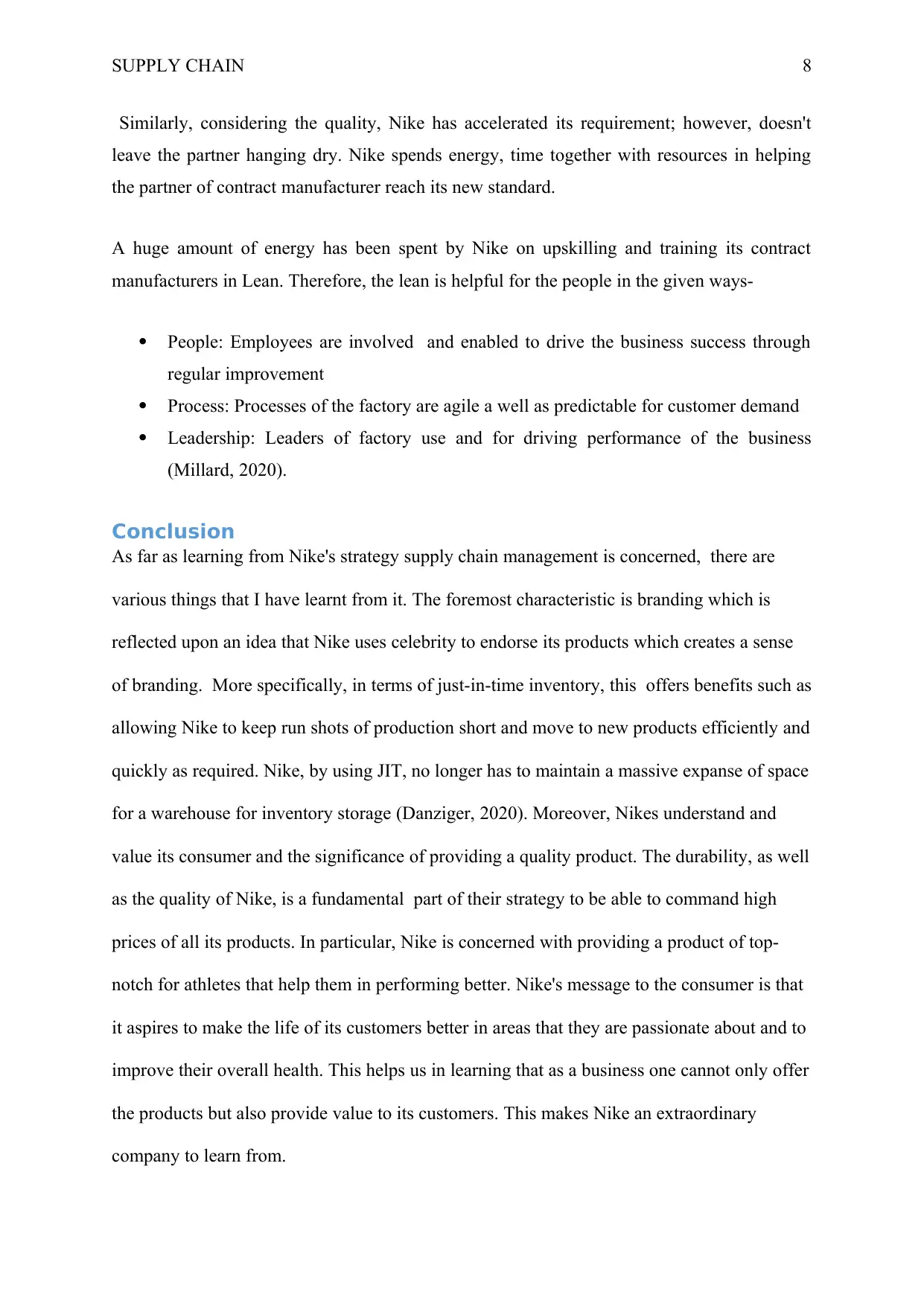
SUPPLY CHAIN 8
Similarly, considering the quality, Nike has accelerated its requirement; however, doesn't
leave the partner hanging dry. Nike spends energy, time together with resources in helping
the partner of contract manufacturer reach its new standard.
A huge amount of energy has been spent by Nike on upskilling and training its contract
manufacturers in Lean. Therefore, the lean is helpful for the people in the given ways-
People: Employees are involved and enabled to drive the business success through
regular improvement
Process: Processes of the factory are agile a well as predictable for customer demand
Leadership: Leaders of factory use and for driving performance of the business
(Millard, 2020).
Conclusion
As far as learning from Nike's strategy supply chain management is concerned, there are
various things that I have learnt from it. The foremost characteristic is branding which is
reflected upon an idea that Nike uses celebrity to endorse its products which creates a sense
of branding. More specifically, in terms of just-in-time inventory, this offers benefits such as
allowing Nike to keep run shots of production short and move to new products efficiently and
quickly as required. Nike, by using JIT, no longer has to maintain a massive expanse of space
for a warehouse for inventory storage (Danziger, 2020). Moreover, Nikes understand and
value its consumer and the significance of providing a quality product. The durability, as well
as the quality of Nike, is a fundamental part of their strategy to be able to command high
prices of all its products. In particular, Nike is concerned with providing a product of top-
notch for athletes that help them in performing better. Nike's message to the consumer is that
it aspires to make the life of its customers better in areas that they are passionate about and to
improve their overall health. This helps us in learning that as a business one cannot only offer
the products but also provide value to its customers. This makes Nike an extraordinary
company to learn from.
Similarly, considering the quality, Nike has accelerated its requirement; however, doesn't
leave the partner hanging dry. Nike spends energy, time together with resources in helping
the partner of contract manufacturer reach its new standard.
A huge amount of energy has been spent by Nike on upskilling and training its contract
manufacturers in Lean. Therefore, the lean is helpful for the people in the given ways-
People: Employees are involved and enabled to drive the business success through
regular improvement
Process: Processes of the factory are agile a well as predictable for customer demand
Leadership: Leaders of factory use and for driving performance of the business
(Millard, 2020).
Conclusion
As far as learning from Nike's strategy supply chain management is concerned, there are
various things that I have learnt from it. The foremost characteristic is branding which is
reflected upon an idea that Nike uses celebrity to endorse its products which creates a sense
of branding. More specifically, in terms of just-in-time inventory, this offers benefits such as
allowing Nike to keep run shots of production short and move to new products efficiently and
quickly as required. Nike, by using JIT, no longer has to maintain a massive expanse of space
for a warehouse for inventory storage (Danziger, 2020). Moreover, Nikes understand and
value its consumer and the significance of providing a quality product. The durability, as well
as the quality of Nike, is a fundamental part of their strategy to be able to command high
prices of all its products. In particular, Nike is concerned with providing a product of top-
notch for athletes that help them in performing better. Nike's message to the consumer is that
it aspires to make the life of its customers better in areas that they are passionate about and to
improve their overall health. This helps us in learning that as a business one cannot only offer
the products but also provide value to its customers. This makes Nike an extraordinary
company to learn from.

SUPPLY CHAIN 9
⊘ This is a preview!⊘
Do you want full access?
Subscribe today to unlock all pages.

Trusted by 1+ million students worldwide
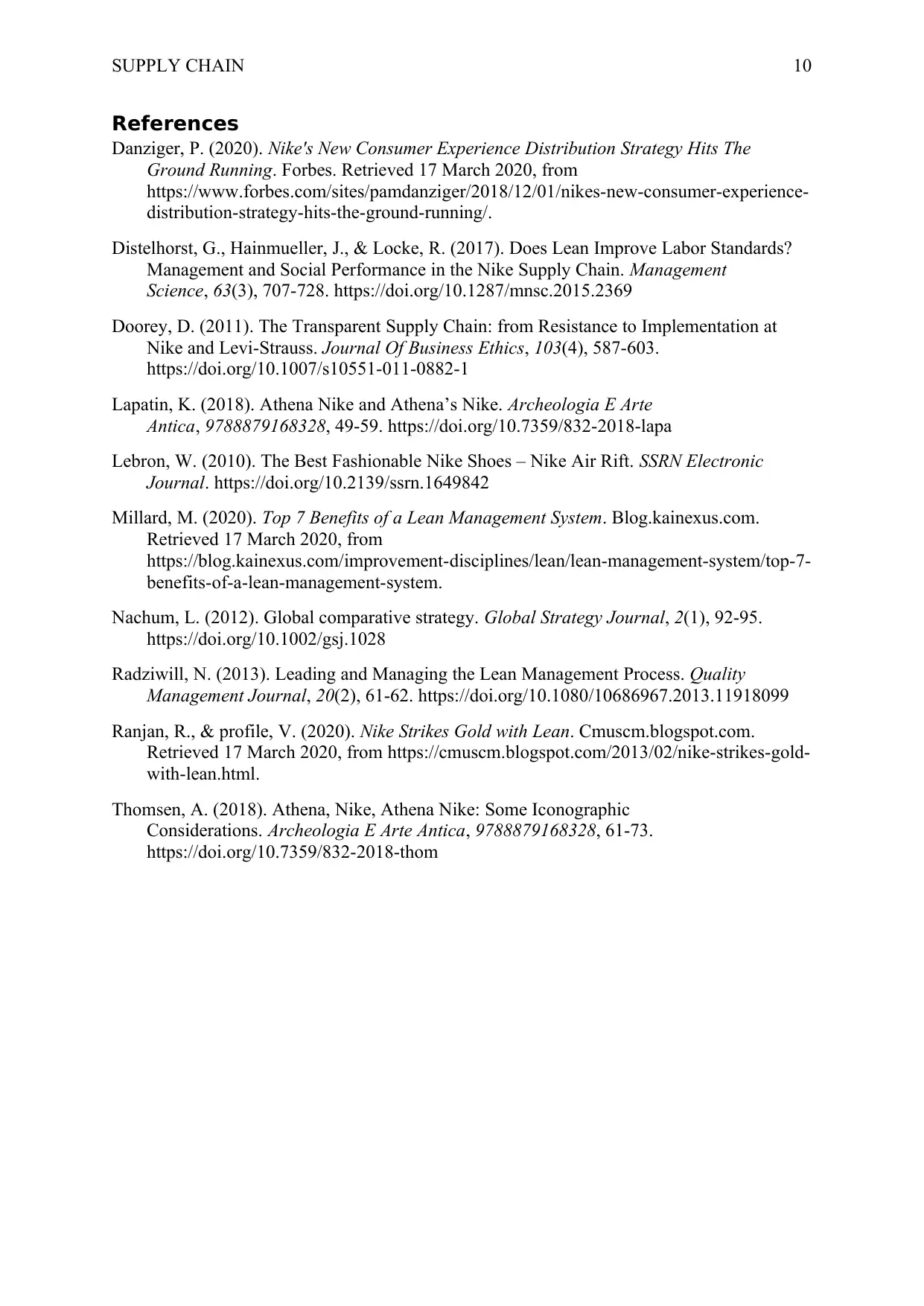
SUPPLY CHAIN 10
References
Danziger, P. (2020). Nike's New Consumer Experience Distribution Strategy Hits The
Ground Running. Forbes. Retrieved 17 March 2020, from
https://www.forbes.com/sites/pamdanziger/2018/12/01/nikes-new-consumer-experience-
distribution-strategy-hits-the-ground-running/.
Distelhorst, G., Hainmueller, J., & Locke, R. (2017). Does Lean Improve Labor Standards?
Management and Social Performance in the Nike Supply Chain. Management
Science, 63(3), 707-728. https://doi.org/10.1287/mnsc.2015.2369
Doorey, D. (2011). The Transparent Supply Chain: from Resistance to Implementation at
Nike and Levi-Strauss. Journal Of Business Ethics, 103(4), 587-603.
https://doi.org/10.1007/s10551-011-0882-1
Lapatin, K. (2018). Athena Nike and Athena’s Nike. Archeologia E Arte
Antica, 9788879168328, 49-59. https://doi.org/10.7359/832-2018-lapa
Lebron, W. (2010). The Best Fashionable Nike Shoes – Nike Air Rift. SSRN Electronic
Journal. https://doi.org/10.2139/ssrn.1649842
Millard, M. (2020). Top 7 Benefits of a Lean Management System. Blog.kainexus.com.
Retrieved 17 March 2020, from
https://blog.kainexus.com/improvement-disciplines/lean/lean-management-system/top-7-
benefits-of-a-lean-management-system.
Nachum, L. (2012). Global comparative strategy. Global Strategy Journal, 2(1), 92-95.
https://doi.org/10.1002/gsj.1028
Radziwill, N. (2013). Leading and Managing the Lean Management Process. Quality
Management Journal, 20(2), 61-62. https://doi.org/10.1080/10686967.2013.11918099
Ranjan, R., & profile, V. (2020). Nike Strikes Gold with Lean. Cmuscm.blogspot.com.
Retrieved 17 March 2020, from https://cmuscm.blogspot.com/2013/02/nike-strikes-gold-
with-lean.html.
Thomsen, A. (2018). Athena, Nike, Athena Nike: Some Iconographic
Considerations. Archeologia E Arte Antica, 9788879168328, 61-73.
https://doi.org/10.7359/832-2018-thom
References
Danziger, P. (2020). Nike's New Consumer Experience Distribution Strategy Hits The
Ground Running. Forbes. Retrieved 17 March 2020, from
https://www.forbes.com/sites/pamdanziger/2018/12/01/nikes-new-consumer-experience-
distribution-strategy-hits-the-ground-running/.
Distelhorst, G., Hainmueller, J., & Locke, R. (2017). Does Lean Improve Labor Standards?
Management and Social Performance in the Nike Supply Chain. Management
Science, 63(3), 707-728. https://doi.org/10.1287/mnsc.2015.2369
Doorey, D. (2011). The Transparent Supply Chain: from Resistance to Implementation at
Nike and Levi-Strauss. Journal Of Business Ethics, 103(4), 587-603.
https://doi.org/10.1007/s10551-011-0882-1
Lapatin, K. (2018). Athena Nike and Athena’s Nike. Archeologia E Arte
Antica, 9788879168328, 49-59. https://doi.org/10.7359/832-2018-lapa
Lebron, W. (2010). The Best Fashionable Nike Shoes – Nike Air Rift. SSRN Electronic
Journal. https://doi.org/10.2139/ssrn.1649842
Millard, M. (2020). Top 7 Benefits of a Lean Management System. Blog.kainexus.com.
Retrieved 17 March 2020, from
https://blog.kainexus.com/improvement-disciplines/lean/lean-management-system/top-7-
benefits-of-a-lean-management-system.
Nachum, L. (2012). Global comparative strategy. Global Strategy Journal, 2(1), 92-95.
https://doi.org/10.1002/gsj.1028
Radziwill, N. (2013). Leading and Managing the Lean Management Process. Quality
Management Journal, 20(2), 61-62. https://doi.org/10.1080/10686967.2013.11918099
Ranjan, R., & profile, V. (2020). Nike Strikes Gold with Lean. Cmuscm.blogspot.com.
Retrieved 17 March 2020, from https://cmuscm.blogspot.com/2013/02/nike-strikes-gold-
with-lean.html.
Thomsen, A. (2018). Athena, Nike, Athena Nike: Some Iconographic
Considerations. Archeologia E Arte Antica, 9788879168328, 61-73.
https://doi.org/10.7359/832-2018-thom
1 out of 10
Related Documents
Your All-in-One AI-Powered Toolkit for Academic Success.
+13062052269
info@desklib.com
Available 24*7 on WhatsApp / Email
![[object Object]](/_next/static/media/star-bottom.7253800d.svg)
Unlock your academic potential
Copyright © 2020–2025 A2Z Services. All Rights Reserved. Developed and managed by ZUCOL.





